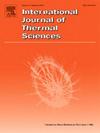基于一维闪蒸模型的改进集总参数液滴闪蒸模型
IF 4.9
2区 工程技术
Q1 ENGINEERING, MECHANICAL
International Journal of Thermal Sciences
Pub Date : 2025-04-27
DOI:10.1016/j.ijthermalsci.2025.109950
引用次数: 0
摘要
喷雾闪蒸技术广泛应用于各种工业和医疗领域,包括能源利用、化工、核电站、制药工程等。实现喷雾闪蒸过程的精确数值模拟至关重要。根据液滴闪蒸过程中蒸发残渣与时间在半对数尺度上的线性关系,基于一维闪蒸模型对传统的液滴集总参数闪蒸模型进行了修正,以提高液滴温度瞬态特性的预测精度。结果表明,与未修正的集总参数模型相比,修正后的模型与一维闪蒸模型和实验数据的一致性更好。修正后的模型能准确预测液滴的温度变化。随后,本研究将重点放在垂直闪蒸容器上,在欧拉-拉格朗日框架下,使用用户定义函数(UDF)将改进的集总参数闪蒸模型实现到商业软件ANSYS Fluent中。将原模型和改进后的闪蒸模型的数值模拟结果与实验数据进行了比较,验证了改进后的喷雾闪蒸数值模拟的准确性。此外,通过对喷雾闪蒸过程的三维数值模拟,分析了蒸汽和液滴的瞬态特性。本研究提出了一种改进的集总参数液滴闪蒸模型和喷雾闪蒸数值模拟方法,为深入了解喷雾闪蒸过程及其工业应用提供了有效的工具。本文章由计算机程序翻译,如有差异,请以英文原文为准。
A modified lumped parameter droplet flash evaporation model based on one-dimensional flash evaporation model
Spray flash evaporation technology is widely applied in various industrial and medical fields, including energy utilization, chemical engineering, nuclear power plants, and pharmaceutical engineering. Achieving accurate numerical simulation of the spray flash evaporation process is critical. According to the linear relationship between the evaporation residue and time on the semi-logarithmic scale during droplet flash evaporation, this study modifies the conventional droplet lumped parameter flash evaporation model based on one-dimensional flash evaporation model to improve the prediction accuracy of the transient characteristics of the droplet temperature. The results demonstrate that the modified model provides better agreement with both the one-dimensional flash evaporation model and experimental data compared to the unmodified lumped parameter model. The modified model can accurately predict the temperature variation of droplets. Subsequently, this study focuses on a vertical flash vessel, where the modified lumped parameter flash evaporation model is implemented into commercial software ANSYS Fluent within the Eulerian-Lagrangian framework using User Defined Functions (UDF). The numerical simulation results of the original model and the modified flash evaporation model are compared with experimental data, verifying the accuracy of the modified spray flash evaporation numerical simulation. Furthermore, through three-dimensional numerical simulation of the spray flash evaporation process, the transient characteristics of vapor and droplets are analyzed. This study proposes a modified lumped parameter droplet flash evaporation model and a spray flash numerical simulation method, which provide effective tools for a deeper understanding of the spray flash process and its industrial applications.
求助全文
通过发布文献求助,成功后即可免费获取论文全文。
去求助
来源期刊

International Journal of Thermal Sciences
工程技术-工程:机械
CiteScore
8.10
自引率
11.10%
发文量
531
审稿时长
55 days
期刊介绍:
The International Journal of Thermal Sciences is a journal devoted to the publication of fundamental studies on the physics of transfer processes in general, with an emphasis on thermal aspects and also applied research on various processes, energy systems and the environment. Articles are published in English and French, and are subject to peer review.
The fundamental subjects considered within the scope of the journal are:
* Heat and relevant mass transfer at all scales (nano, micro and macro) and in all types of material (heterogeneous, composites, biological,...) and fluid flow
* Forced, natural or mixed convection in reactive or non-reactive media
* Single or multi–phase fluid flow with or without phase change
* Near–and far–field radiative heat transfer
* Combined modes of heat transfer in complex systems (for example, plasmas, biological, geological,...)
* Multiscale modelling
The applied research topics include:
* Heat exchangers, heat pipes, cooling processes
* Transport phenomena taking place in industrial processes (chemical, food and agricultural, metallurgical, space and aeronautical, automobile industries)
* Nano–and micro–technology for energy, space, biosystems and devices
* Heat transport analysis in advanced systems
* Impact of energy–related processes on environment, and emerging energy systems
The study of thermophysical properties of materials and fluids, thermal measurement techniques, inverse methods, and the developments of experimental methods are within the scope of the International Journal of Thermal Sciences which also covers the modelling, and numerical methods applied to thermal transfer.
 求助内容:
求助内容: 应助结果提醒方式:
应助结果提醒方式:


